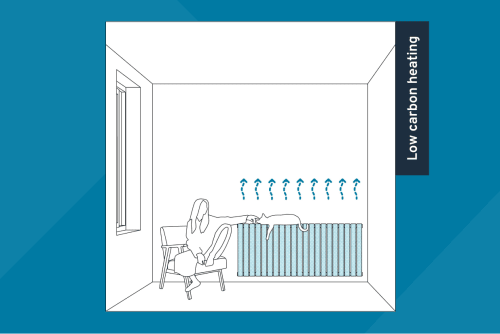My radiators are always cold - I don’t think my heating system is working properly.
Low carbon heating systems work more efficiently when the hot water is distributed around radiators and under floor heating at lower temperatures than would be the case for a gas system.
Typically, the optimum temperature is around 30-40°C and manufacturers publish performance information to help optimise distribution temperatures. To make sure that the home has enough heat the emitters (i.e.radiators) tend to be larger. Qualitatively, the warmth is different: the radiators may not feel hot, but comfort levels should be the same. In fact, if the radiators do feel hot something is likely to be wrong with the operation or design.
Designing the system requires a different approach from a conventional gas boiler using knowledge and expertise specific to the heating system and this in turn requires a good understanding of each home’s heat loss characteristics. The ‘as-built’ home must also match the predicted performance at the design stage and unintended heat losses, through missing insulation or changed products, will have consequences for the efficiency of the heating system.
In the Energy Saving Trust’s (EST) field trials of installed systems in use, it was found that the best performing systems were those deemed to be properly designed and installed. Oversizing the heat pump can just as easily lead to inefficiencies as undersizing it. Indeed, in the second stage of the trial more than 12% of the heat pumps were replaced with smaller units in order to deliver adequate efficiencies.
Things that can go wrong:
- poor seasonal efficiencies because of design and installation
- consumer misunderstanding of control systems and characteristics
- slow heat up times (with non-continuous control strategies)
- supplementary heating needed (less efficient and with higher emissions).
Future-proofing recommendations:
- DESIGN: Design the system correctly; Allow enough space for larger radiators and hot water cylinder and access to all the parts
- INSTALL: Avoid product substitutions and deviations from the design
- COMMISSION: Commission all components and the completed system
- MAINTAIN: Provide a demonstration of systems at handover and back this up with information for householders and clear guidance on maintenance.
Further Reading
MCS, Domestic heat pumps - a best practice guide
Heat pumps run most efficiently with low distribution temperatures and the heat emitters (radiators) need to be sized accordingly. If they feel hot to touch it may be a sign that the room is poorly insulated. (MCS, Domestic heat pumps - a best practice guide, 2020, p16-18)
EDF, The gas boiler ban - everything you need to know,
All new homes are banned from installing gas and oil boilers from 2025 and needing low carbon alternatives. (EDF, The gas boiler ban - everything you need to know, web article accessed 20 July 2022)
Report Chapters
Explore NHBC Foundation

About NHBC Foundation research
Delivering high-quality research and guidance to help the house-building industry address the challenges of delivering 21st-century new homes.

Access NHBC Foundation publications
Access and download NHBC Foundation’s full portfolio of publications and practical guides, covering primary research, research reviews and documents informing the debate.

Latest NHBC Foundation news
View the latest NHBC Foundation news, articles and facts showcasing the most recent publications and reporting on progress with new research projects.
Technical disclaimer
The information provided or contained on this website has been produced by NHBC for research and guidance purposes through the “NHBC Foundation”. It has not been created or intended for distribution or use outside of the purpose for which it was drafted. The information contained on this website does not constitute advice and is not to be relied upon by any third party. Any third party who chooses to rely upon the information contained on this website shall do so entirely at their own risk and NHBC accepts no duty of care or liability, however caused, in connection with its use or reliance by any third party. It is not updated or maintained.
This website may contain links to websites operated by third parties. Third party websites are not under our control, and we are not responsible for the content of any third-party website, or any link contained in a third-party website. NHBC do not review, approve, monitor, endorse, warrant, or make any representations with respect to third party websites. Any third party who chooses to rely upon the information contained on a third-party website shall do so entirely at their own risk. NHBC accepts no duty of care or liability, however caused, in connection with its use or reliance by any third party.
